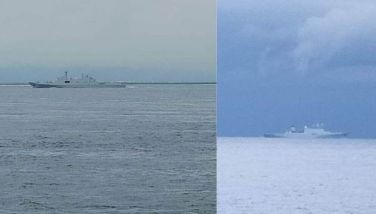East Asian nations form united front vs acid deposition
July 15, 2001 | 12:00am
Recognizing the hazards posed by acid deposition to lives and properties, the Acid Deposition Monitoring Network in East Asia (EANET) has been conducting a series of meetings since 1993. The latest was on June 14-15, 2001 in Bangkok, Thailand. The member countries of EANET are Japan (funding government for the concluded meetings), the Philippines, Thailand, Russia, Malaysia, China, Indonesia, Korea, Mongolia, and Vietnam. Plants for future meetings are also in place.
The general aim of the meetings is to be able to establish and implement effective acid deposition monitoring systems in their respective countries, so that appropriate interventions could be applied. Philippine representatives to these meetings come from the Environmental Management Bureau of the DENR. The country’s monitoring stations are located in UPLB, Ateneo de Manila, and San Pablo City.
Acid deposition is a global environmental issue. Other issues of this nature include ozone layer depletion, global warming, tropical deforestation, desertification, pollution problems in developing countries, endangered species, marine pollution, and transboundary movement of hazardous waters.
Acid deposition affects not only the countries that caused the problems, but go beyond their national boundaries and can reach a global scale. It also requires international efforts for solutions.
Most people think that acid deposition is simply rain that has pH value below 5.6, since information about it are not widely disseminated and discussed. Little is known that it is only a part of acid deposition phenomena.
Acid deposition is a result of the interaction of pollutants such as sulfur dioxide and nitrogen oxides that are emitted to the atmosphere when we burn fossil fuels such as oil and coal from boilers in factories and power plants, and vehicle emissions.
There are two processes in acid deposition. One is wet deposition where sulfuric and nitric acids are incorporated into clouds and fall to the ground in the form of rain, snow, and mists. When a large amount of acid is dissolved in it, rain becomes strongly acidic. This is the acid rain. The other process, which is called dry deposition, occurs on fine and cloudy days. Winds carry airborne acids that are deposited on trees and buildings and over human respiratory systems.
Acid deposition can adversely affect the health of the people who drink rain water and breathe airborne acids. It threatens the existence of fishes and other living creatures when its concentration becomes high in lakes and rivers. It can also be a cause for the death of forests, like what happened in Ashio, Japan and at Kora Peninsula in the western part of Russia. Acid rain dissolves concrete materials, marble floors, sculptures, and even copper roofs.
Consumption of natural resources and acid deposition is closely related. For instance in refining copper from sulfuric copper significant amount of sulfuric dioxide is being emitted. In the process, rivers become polluted.
In the face of this global environmental problem small individual actions in reducing the consumption of fuel and energy is essential. Think globally but act locally, is the appropriate response.
The general aim of the meetings is to be able to establish and implement effective acid deposition monitoring systems in their respective countries, so that appropriate interventions could be applied. Philippine representatives to these meetings come from the Environmental Management Bureau of the DENR. The country’s monitoring stations are located in UPLB, Ateneo de Manila, and San Pablo City.
Acid deposition is a global environmental issue. Other issues of this nature include ozone layer depletion, global warming, tropical deforestation, desertification, pollution problems in developing countries, endangered species, marine pollution, and transboundary movement of hazardous waters.
Acid deposition affects not only the countries that caused the problems, but go beyond their national boundaries and can reach a global scale. It also requires international efforts for solutions.
Most people think that acid deposition is simply rain that has pH value below 5.6, since information about it are not widely disseminated and discussed. Little is known that it is only a part of acid deposition phenomena.
Acid deposition is a result of the interaction of pollutants such as sulfur dioxide and nitrogen oxides that are emitted to the atmosphere when we burn fossil fuels such as oil and coal from boilers in factories and power plants, and vehicle emissions.
There are two processes in acid deposition. One is wet deposition where sulfuric and nitric acids are incorporated into clouds and fall to the ground in the form of rain, snow, and mists. When a large amount of acid is dissolved in it, rain becomes strongly acidic. This is the acid rain. The other process, which is called dry deposition, occurs on fine and cloudy days. Winds carry airborne acids that are deposited on trees and buildings and over human respiratory systems.
Acid deposition can adversely affect the health of the people who drink rain water and breathe airborne acids. It threatens the existence of fishes and other living creatures when its concentration becomes high in lakes and rivers. It can also be a cause for the death of forests, like what happened in Ashio, Japan and at Kora Peninsula in the western part of Russia. Acid rain dissolves concrete materials, marble floors, sculptures, and even copper roofs.
Consumption of natural resources and acid deposition is closely related. For instance in refining copper from sulfuric copper significant amount of sulfuric dioxide is being emitted. In the process, rivers become polluted.
In the face of this global environmental problem small individual actions in reducing the consumption of fuel and energy is essential. Think globally but act locally, is the appropriate response.
BrandSpace Articles
<
>
- Latest
Latest
Latest
March 4, 2024 - 3:32pm
By Ian Laqui | March 4, 2024 - 3:32pm
March 4, 2024 - 2:12pm
By Kristine Daguno-Bersamina | March 4, 2024 - 2:12pm
February 17, 2024 - 2:31pm
February 17, 2024 - 2:31pm
February 13, 2024 - 7:24pm
By Gaea Katreena Cabico | February 13, 2024 - 7:24pm
February 13, 2024 - 7:17pm
By Ian Laqui | February 13, 2024 - 7:17pm
January 30, 2024 - 4:25pm
By Ian Laqui | January 30, 2024 - 4:25pm
Recommended





























